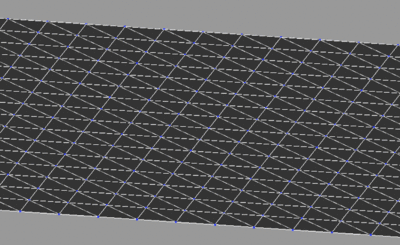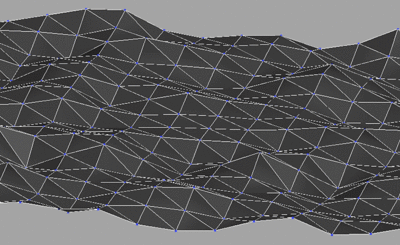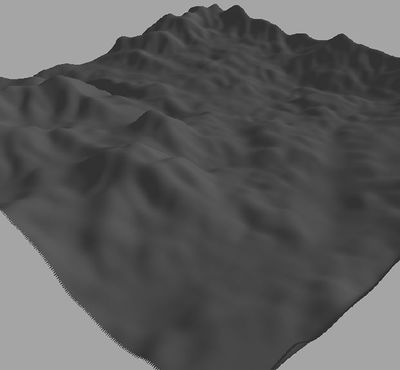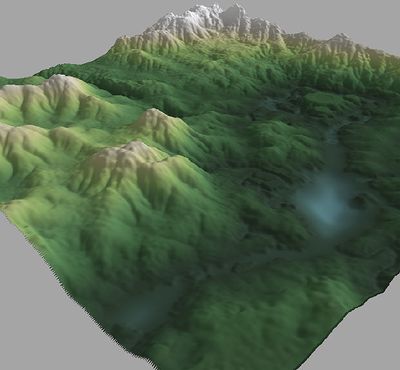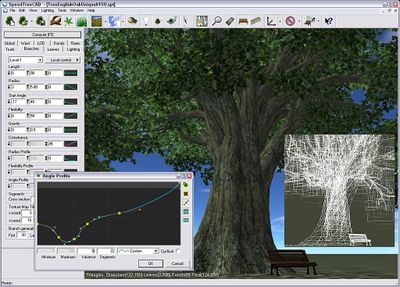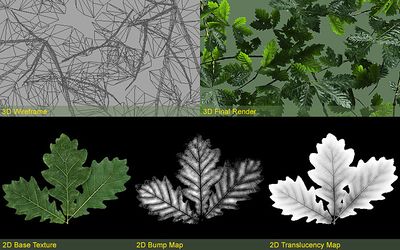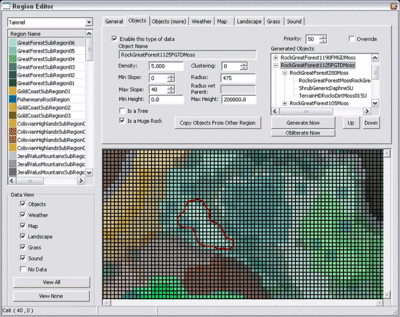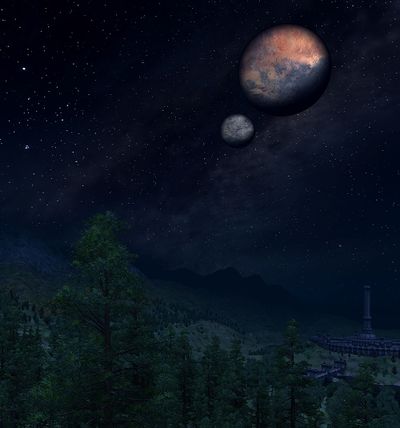This is a developer diary for The Elder Scrolls IV: Oblivion. The original diary can be found here.
By Noah Berry
A Study in Pressure and Time
Nothing in this world we live is static. All is in motion – changing, decaying, growing, and coalescing in a seemingly eternal cycle between the union of birth and death, existence versus nonexistence, or the point of transformation.
With an impossible macro view of our planet's history, we would see readily that the combined forces of heat, pressure, wind, and water take millennia to work their craft upon the ever-changing palette of the Earth. Over time, we would witness the rage and surge of oceans, violent storms as they ebb and flow, and the tiny bits of mineral that drift and slam about in endless gusts of wind - all the while glacially sculpting what you happen to traverse when stepping outside, or what you see looming into focus upon the horizon. We would see that even underneath your very feet, enormous plates of encrusted planetary debris sail and capsize about on a sea of molten metal - a giant spherical flotsam of our ancient, primordial, explosive origin.
Universally speaking, it has taken us forever (or our best grasp of it) just for our current world-view to tumble into frame. Looking up, somehow we are still lost in the middle of it all, infants in time, with nary an end in sight.
During the development of The Elder Scrolls IV: Oblivion, we had maybe a microscopic fraction of that amount of time to help bring an entire landmass to your glowing screens. Scratch that. Given that timetable, our window doesn't even have a prayer of registering to the senses.
OK, so what do we do? We have to ship a game. Not only that, Oblivion has to be the finest RPG we can possibly create. It has to be.
So now what do we do – what's next?
Well, in the grand old Bethesda tradition of starting fresh from scratch, we pause for a moment and contemplate our goal, and then we begin to distill and sift the problem down to the most basic, base elements – in this case, the elements within a simulated 3D space.
A vertex
OK – that doesn't give us much to work with. It won't even render to the screen in the final game.
2 vertices
Better. We can display lines now, which is something. Keep going.
3 vertices
Great, now we're getting somewhere. The space between the vertices can be filled, yielding polygons, which supply us with a surface to manipulate. What happens when we string many of them together?
A Grid
All right, our world is starting to take shape now...but it's a little flat...boring. Let's introduce some variance – let's give each vertex the freedom to move up or down along the z-axis, while still remaining connected as a whole.
A Heightfield
Interesting. Now the terrain surface, while just as simple mesh-wise as before, is taken to a greater degree of visual complexity just from altering the vertex positions along the vertical z-axis. The resulting form has a much more pleasing interaction with even a simple, single light source splaying across the surface.
Ok, we've got points in space and an alterable surface they can manipulate. Let's ramp things up a bit by using some of the new landscaping and painting tools in The Elder Scrolls Construction Set, making the surface of our world huge.
Tamriel is starting to come into focus. Using various height adjusting and vertex smoothing brushes (that work very similarly to those you might find in a 2D paint program such as Photoshop) we were able to push and pull the various vertices of the heightfield into a shape that is beginning to resemble a more natural, multi-featured landscape.
While the coarse shapes are there – mountains, valleys, plateaus, etc., we're still missing out on a lot of high-level detail. Most of the hilly features are far too rounded and dull to be confused with anything in the real world. For starters, there isn't a sufficient amount of visual contrast between the more vertical and horizontal spaces across the land. To polish things up even further, let's try adding some noise and erosion detail to the scene.
There we are...this section of terrain now feels a bit more natural and weathered. With the new landscaping tools in the Construction Set, it is quite easy to add intricate cragginess to an otherwise gentle, ascending slope, or to chisel away yawning chasms by years worth of soil erosion, all from the press of a button. Additionally, we've gone and colorized the different ranges of elevation to help better give a sense of scale and spatial organization to our scene.
We Could Plant a House, We Could Build a Tree
Well we now have terra firma under our feet, but after walking around the world for a while, the countryside still feels rather empty. This is the point in the development cycle where the world artists commence production on all kinds of various landscape art assets – anything from flora, fauna, and rocks to waterfalls. From trees, even to their fallen ancestors, all in order to help us feel a little more grounded and at home within our world.
Cyrodiil, nestled in the heart of Tamriel, is a richly diverse and lush section of countryside. As Imperial naturalists, historians, and TES fans know alike, there are dense swaths of forests and rolling green pastures to be found in the hills and valleys surrounding the Imperial City. As artists, we couldn't really get by with building just a few static trees and dotting them here and there across the land. We need veritable reams of trees, forests ripe for exploring, vast pastures, and foliage filled meadows teeming with flora to trek through.
How in the world were we to do this? Buildings and swords are one matter – we've tackled these types of models pretty successfully before, but lush, moving vegetation? High detail trees that sway and interact with dynamic wind? These are no small undertakings in 3D worlds that are generally constructed out of straight lines and hard angles. In order to pull off this kind of graphic effect successfully, we needed to add some new tools to our repertoire. Fortunately for us this time around, the Oblivion developers had a few tricks up their collective sleeves.
To tackle the problem of creating high detail, and fully animating foliage and tree art, we solicited the aid of IDV's SpeedTree technology. Oblivion artists were able to quickly generate complex and organic tree shapes with relative ease, thanks to a highly streamlined, yet powerful and intuitive interface. Using parent/child hierarchies and iterative branch levels comprised of highly modifiable cylinder primitives, an entire tree shape can be created in a manner of minutes, just by adjusting numerical values and tweaking spline curve handles.
The resulting shapes are very similar to what the artists normally would painstakingly create by hand, polygon by polygon, within a modeling program. Perhaps best of all, the tree objects created save the artists even more time by being innately rigged for animation. After the programmers made our engine render and animate the trees, artists were able to quickly place their models in the game and carefully observe the results in real-time.
Well now that the tree shapes are established, and our world is looking a little less barren now, what about the greenery, foliage, and the very leaves on the trees themselves? Glancing up at an Earthly forest canopy, we are presented with an amazing array of dense, mottled shapes and complex, overlapping patterns of light and color. Rays of sunlight spill downward, filtering through layers of leaves and needles of varying thickness and weight, while the cell and chlorophyll filled vegetation reacts with and modulates the blanket of the starlight in subtle ways.
This is all well and good in description, or for film and pre-rendering, but real-time graphics of this variety and complexity can bring video cards and GPUs to their very knees. Surely we can't render each leaf individually as that would be an inordinate strain on the computer, taxing the hardware to its limits. Even the interaction of light and foliage in a real-time environment is beyond our current technological reach. Nevertheless, we'd like to achieve these visual effects...somehow.
In the end, to circumvent this particular visual hurdle, the Oblivion artists put their 3D skills to the test and displayed their mettle in organic modeling. Typically, foliage portrayed within interactive entertainment is comprised largely of real-world photographs and Photoshop manipulation. The same is still true for Oblivion, but in this case, the artists really went the extra mile for detail and visual fidelity. In order to try and capture some of the natural translucency and light play that tree greenery and foliage displays, a method of modeling foliage in high detail 3D was developed.
We would start by building the foliage via relatively simple geometry meshes inside of a modeling program and gradually increase the complexity through instancing and clever arranging, until an entire tree bough was created. Using these shapes, combined with high detail leaf/vegetation images and a controlled, fixed camera perspective, we were able to render out crisp and colorful leaf textures that gave us better results than those we could hope to capture in the real world. These renderings were in turn converted into textures that were placed upon the trunk shapes as foliage. As with the branch meshes, these naturally animate and vary in motion - effectively giving the trees that you see within the game world a much more fluid and lifelike quality.
Out of the Ground, Into the Sky
Now that we have sturdy, gnarled trunks standing tall, and the dense shroud of a forest canopy shading our virtual avatar – our artist eyes wander once again to the ground. As one can imagine, Cyrodiil isn't a golf course, and the inhabitants certainly don't mow their lawns, at least not without the aid of their sheep. Indeed, just stepping foot off of the Imperial highways, one will find themselves waist deep in all manner of vegetation and landscape clutter. From wild grasses, to seed bearing herbs jutting out amongst fields of haphazardly strewn rocks left ages ago by long forgotten glaciers, resting upon folds in the hills, like wounded soldiers waiting for their loved ones to carry them home.
How does it all get there? Sure we can say the glaciers are responsible, and claim that the mushrooms just magically sprung up where they are, but in reality, the artists must place all of this content and detail...somehow. Ok, so what are we talking about, hundreds of thousands of references? Sure! No problem...we'll be finished, oh, sometime in the next 10 years or so. I'm sure everyone patiently waiting would be thrilled about this notion, but surely we'd go collectively mad trying to micromanage detail on that scale. What we need is a way to place thousands of references in our world and have them be arranged in such a way as to look like they've always been there.
Thanks again to our programmers and to expanded Construction Set functionality, an immensely intricate and dense landscape overflowing with detail is now within our grasp. With the addition of the Region Editor toolset, world artists are able to select a worldspace (in this case Cyrodiil) and define an abstract 2D region shape, which encompasses a smaller portion of the overall landscape. These region shapes are drawn with as much, or as little complexity as the user desires and will appropriately shade whichever areas are within range of the region boundary.
Each region type contains a large list of parameters that help define what goes into a region – from rocks to trees to landscape textures – as well as how the items are distributed. For example, the user has control over object density, size, scale, orientation, clustering, etc. and just about anything listed as a reference in the editor could be generated on the landscape given this system. If one were so inclined, a city of barrels settled within a vast forest of gigantic crates is just a few button presses away. Time To Crate = 0
Here is a sampling of the many landscape items one might encounter during their adventures in TESIV: Oblivion
35,544 shrubs and bushes
67,730 Plants and Mushrooms
94,013 Trees and Fallen Logs
395,696 Rocks
The region editor is an invaluable asset when populating the surface of Tamriel. Through it we can recreate entire ecosystems, from the scale of an entire forest, all the way down to a ring of mushrooms around the base of a tree, and set up all manner of life and vegetation that the player might encounter on their own unique adventure through the countryside of Cyrodiil.
| West Weald Flora | |
|
|
| West Weald Flora Cont. | |
|
|
| West Weald Panorama | |
|
|
At this point, Cyrodiil is more tactile to the senses than ever before. The player is nearly enwombed on all sides by lush visuals and ever changing scenery – all sides save one. As we look around our world, our gaze turns once again to the only remaining space to fill...the sky.
In more ancient times, it was common for people to turn to the heavens in times of spiritual need. The thinking being, that there above lies the answers otherwise unobtainable here on the ground. I believe it's fair to say the general populace of Tamriel collectively thinks along similar pathways – for good reason. It is well known there, that special powers are derived from the synergistic energies related to celestial gatherings and patterns. Even the mysterious, ancestral denizens of Tamriel, the Dwarves, were all too aware of the impact of the night sky on their daily lives and went to great lengths to study and understand their place in it all.
For the skies and heavenly bodies above Cyrodiil, the Oblivion developers made some technical improvements on several fronts. Gazing upwards, one might initially notice that there are now dual cloud layers placed in tandem, which naturally parallax from their different rates of travel. The resulting effect affords a skyward view much more depth and a greater sense of spaciousness.
There are also subtle lighting changes to be had based upon where the player is in relation to the immediate environment. In order to better simulate the generally more intense luminance of the sky, High Dynamic Range (HDR) lighting and shader effects were meticulously incorporated into Oblivion's renderer, to better give a more photorealistic flair to the atmosphere visuals.
Lastly, as the sun drifts gently downward in the westward sky, and the evening kaleidoscope of pastels fades and diffuses into the deepest of blues, distant stars and galaxies begin to scintillate into view. Here, for the first time, all of the 13 major Elder Scrolls constellations are visible to the player. In order to realistically display the star arrangements properly, a new, fully 3D spherical night sky dome was created. Through the in-game passage of time, the player should be able to track the stars above, as they lazily spiral about the ocular curve of the night sky.
With our world complete, and Cyrodiil fully realized, the player is free to roam this vast and varied landscape to their hearts content. As with our world, Cyrodiil is in constant motion. The trees and grasses sway with the ever-changing wind. Clouds drift hazily overhead and storms amass and fade into the quiet of the morning. Even the very curtain of stars, celestial objects that are worlds away, are never at rest. Even they are always churning and spiraling, deep within the cosmos, forever burning bright until they sigh their last solar wind, giving eventual rise to a new star.
The developers of TES IV: Oblivion wish to bestow upon you the player, a thoroughly enjoyable journey during your visit to heart of the Imperial Empire, and the surrounding lands and countryside. On our never-ending quest for greater immersion, visual fidelity, detail, complexity and fun, we sincerely hope that we've brought a unique and wonderful experience to your computers and consoles. An experience so deep and rife with possibilities that perhaps it could even inspire one to contemplate the nature of Tamriel and their own avatar's existence.

